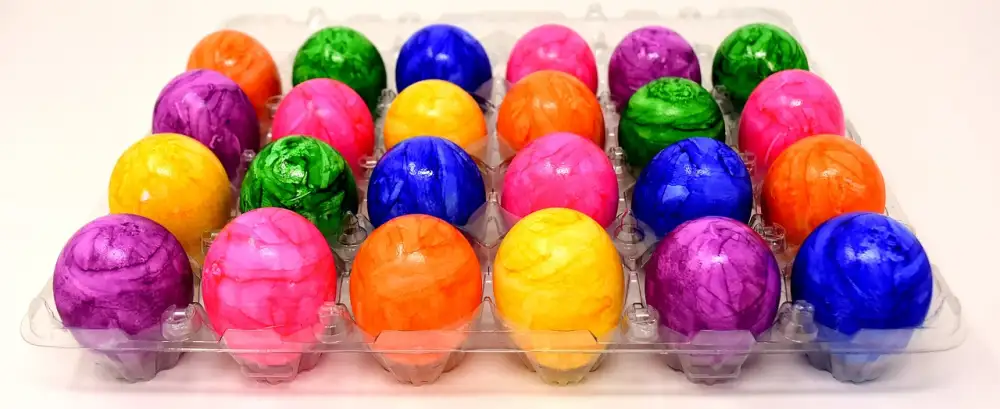Delight in the Divine Flavors of Easter Bread: A Traditional Recipe to Celebrate the Season at Home

- History and Significance of Easter Bread
- Ingredients Required for Making Easter Bread
- Step-by-Step Instructions for Making Easter Bread
- Tips and Tricks for Perfectly Fluffy Easter Bread
- Variations and Additions to Elevate Your Easter Bread
- Serving Suggestions and Pairings for Easter Bread
- Storing and Preserving Easter Bread for Enjoyment Later
Easter is a time of joy, renewal, and celebration. And what better way to commemorate this special season than with a homemade Easter bread? This delectable treat has been a beloved tradition in many cultures for centuries, bringing families together and filling homes with the heavenly aroma of freshly baked bread. Whether you're a seasoned baker or just starting out, making Easter bread is a delightful way to express your love for food and create cherished memories with loved ones. So let's dive into the history, ingredients, and step-by-step instructions for crafting this divine delicacy at home!
History and Significance of Easter Bread
Easter bread holds a rich history and deep significance in many cultures around the world. Its origins can be traced back to ancient times when bread was considered a sacred food, symbolizing life and fertility. In Christian traditions, Easter bread represents the resurrection of Jesus Christ and is often baked and shared during the Easter season.
The shape of the bread varies across different regions, with braided or twisted loaves being popular choices. These shapes symbolize unity, as they bring together multiple strands of dough to form a single loaf. The use of eggs in Easter bread also carries symbolic meaning, representing new life and rebirth.
Throughout history, Easter bread has been prepared with great care and love, often using traditional family recipes that have been passed down through generations. It is not only a delicious treat but also a way to connect with our ancestors and honor their culinary traditions.
By baking Easter bread at home, we can participate in this centuries-old tradition and create lasting memories with loved ones. It is an opportunity to celebrate the season's spiritual significance while indulging in the heavenly flavors of this beloved delicacy.
Ingredients Required for Making Easter Bread
To make delicious Easter bread, you will need the following ingredients:
- 4 cups all-purpose flour
- 1/2 cup granulated sugar
- 1/2 teaspoon salt
- 2 packets active dry yeast
- 1/2 cup warm milk
- 1/2 cup unsalted butter, melted
- 4 large eggs, beaten
- 1 teaspoon vanilla extract
- Zest of 1 lemon or orange (optional)
- 1/2 cup raisins or currants (optional)
These simple yet essential ingredients come together to create a soft and flavorful Easter bread that is perfect for celebrating the season.
Step-by-Step Instructions for Making Easter Bread
Step 4: Step-by-Step Instructions for Making Easter Bread
1. In a large mixing bowl, combine warm milk, yeast, and sugar. Let it sit for about 5 minutes until the mixture becomes frothy.
2. Add melted butter, eggs, vanilla extract, and salt to the yeast mixture. Mix well.
3. Gradually add flour to the mixture while stirring continuously until a soft dough forms.
4. Transfer the dough onto a floured surface and knead for about 10 minutes until it becomes smooth and elastic.
5. Place the dough in a greased bowl, cover it with a clean kitchen towel, and let it rise in a warm place for about 1-2 hours or until doubled in size.
6. Punch down the dough to release any air bubbles and divide it into equal portions depending on the desired size of your bread.
7. Shape each portion into a round loaf or braid them together for an intricate design.
8. Place the shaped loaves on a baking sheet lined with parchment paper and cover them with a kitchen towel. Allow them to rise again for about 30 minutes.
9. Preheat your oven to 350°F (175°C). Brush the risen loaves with beaten egg wash for a golden crust.
10. Bake the Easter bread in the preheated oven for approximately 25-30 minutes or until they turn golden brown and sound hollow when tapped on the bottom.
11. Remove from the oven and let them cool on wire racks before serving.
Enjoy your homemade Easter bread!
Tips and Tricks for Perfectly Fluffy Easter Bread
To achieve perfectly fluffy Easter bread, here are some tips and tricks to keep in mind. First, make sure your yeast is fresh and active by proofing it in warm water with a pinch of sugar before adding it to the dough. This will ensure a good rise. Secondly, knead the dough well for at least 10 minutes to develop gluten and create a light texture. Thirdly, allow the dough to rise in a warm, draft-free place until it has doubled in size. This may take anywhere from 1-2 hours. Lastly, when shaping the dough into braids or rolls, handle it gently to avoid deflating the risen dough. Follow these tips and you'll have beautifully fluffy Easter bread every time!
Variations and Additions to Elevate Your Easter Bread
While traditional Easter bread is a delight on its own, you can add some creative twists to make it even more special. Here are a few ideas to elevate your Easter bread:
1. Fruity Delight: Incorporate dried fruits like raisins, currants, or chopped apricots into the dough for bursts of sweetness in every bite.
2. Nutty Goodness: Toasted almonds, walnuts, or pistachios can add a delightful crunch to your Easter bread. Simply sprinkle them on top before baking.
3. Zesty Citrus: Add a refreshing twist by including grated lemon or orange zest in the dough. The citrusy aroma will fill your kitchen with an irresistible fragrance.
4. Chocolate Indulgence: For all the chocolate lovers out there, consider adding chocolate chips or chunks to the dough for a decadent treat.
5. Spiced Sensation: Experiment with warm spices like cinnamon, nutmeg, or cardamom to infuse your Easter bread with aromatic flavors that will tickle your taste buds.
Remember, these variations are just suggestions - feel free to get creative and personalize your Easter bread according to your preferences.
Serving Suggestions and Pairings for Easter Bread
When it comes to serving Easter bread, the options are endless. This delicious treat can be enjoyed in a variety of ways. One classic way to serve Easter bread is simply sliced and enjoyed on its own. The soft, fluffy texture and sweet flavor make it a delightful snack or breakfast option.
For a more indulgent treat, try toasting slices of Easter bread and spreading them with butter or cream cheese. The warmth of the toasted bread enhances the flavors even more, creating a truly heavenly experience.
If you're looking for a unique twist, consider using Easter bread as the base for French toast. Dip thick slices of bread in an egg mixture and cook them on a griddle until golden brown. Top with powdered sugar, fresh fruit, or maple syrup for an extra special brunch dish.
Easter bread also pairs well with a variety of spreads and toppings. Try serving it with honey or jam for a touch of sweetness, or pair it with savory options like cheese or cured meats for a more substantial snack.
For an elegant dessert option, serve Easter bread alongside a scoop of vanilla ice cream or whipped cream. The combination of the warm bread and cold creamy topping is simply divine.
No matter how you choose to serve it, Easter bread is sure to be a hit among family and friends. Its versatility makes it suitable for any occasion – from casual gatherings to formal celebrations.
So go ahead and get creative with your serving suggestions – let your imagination run wild! And don't forget to share the love by gifting homemade Easter bread to your loved ones. It's the perfect way to spread joy during this festive season.
Storing and Preserving Easter Bread for Enjoyment Later
If you find yourself with leftover Easter bread, don't fret! There are a few simple ways to store and preserve it for later enjoyment. Firstly, make sure the bread has cooled completely before storing. Wrap it tightly in plastic wrap or place it in an airtight container to prevent it from drying out.
For short-term storage, you can keep the bread at room temperature for up to 2 days. However, if you want to enjoy it for longer, refrigeration is the way to go. Easter bread can stay fresh in the refrigerator for up to a week. Just remember to bring it back to room temperature before serving.
To freeze your Easter bread, slice it into individual portions and wrap them tightly in plastic wrap or aluminum foil. Place the wrapped slices in a freezer-safe bag or container and label them with the date. Frozen Easter bread can be enjoyed for up to 3 months.
When you're ready to enjoy your stored Easter bread, simply thaw it at room temperature or reheat it gently in the oven for a few minutes. The flavors will still be divine, and you'll have a taste of Easter long after the season has passed.
By following these storage tips, you can savor every last crumb of your homemade Easter bread and continue celebrating the season even after Easter Sunday has come and gone.
As we conclude our journey into the delightful world of Easter bread, it's clear that this traditional recipe is more than just a delicious treat. It's a way to express love and celebrate the season with family and friends.
By taking the time to make your own Easter bread, you are not only honoring a centuries-old tradition but also creating memories that will last a lifetime. The process of kneading the dough, watching it rise, and savoring the heavenly aroma as it bakes is truly magical.
So, this Easter season, gather your loved ones in the kitchen and embark on this culinary adventure together. Let laughter fill the air as you shape the dough into intricate braids or creative shapes. Share stories and traditions while waiting for your masterpiece to come out of the oven.
And when it's finally time to enjoy your homemade Easter bread, remember to savor every bite. Take pleasure in its fluffy texture, delicate sweetness, and subtle hints of spices. Pair it with a cup of tea or coffee for an indulgent treat.
But don't stop there - share your love for Easter bread with others too! Wrap up a loaf beautifully and gift it to someone special. Spread joy by sharing this timeless tradition with neighbors, colleagues, or those in need.
In these uncertain times, let us find solace in cherished traditions like making Easter bread. Let us connect with our roots and celebrate life's simple pleasures. And above all, let us share the love that goes into every homemade loaf.
Happy baking and happy Easter!
Published: 31. 12. 2023
Category: Home



